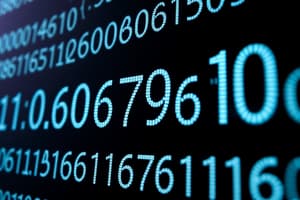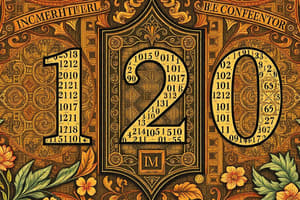Podcast
Questions and Answers
What is the base of the binary numeral system?
What is the base of the binary numeral system?
- Base-2 (correct)
- Base-16
- Base-8
- Base-10
What does each bit in a binary number represent?
What does each bit in a binary number represent?
- An octal value
- A hexadecimal value
- A power of 2 (correct)
- A decimal value
How is the decimal number 11 represented in binary?
How is the decimal number 11 represented in binary?
- 1001
- 1100
- 1010
- 1011 (correct)
Which of the following describes a limitation of the binary system?
Which of the following describes a limitation of the binary system?
What is the result of binary addition when adding 1 and 1?
What is the result of binary addition when adding 1 and 1?
In binary counting, what follows 111?
In binary counting, what follows 111?
What is one advantage of using the binary system in electronics?
What is one advantage of using the binary system in electronics?
What is a common application of the binary system?
What is a common application of the binary system?
Which method is used to convert a decimal number to binary?
Which method is used to convert a decimal number to binary?
Which character encoding standard uses binary for data representation?
Which character encoding standard uses binary for data representation?
Flashcards are hidden until you start studying
Study Notes
Binary System
-
Definition: The binary system is a base-2 numeral system that uses only two digits: 0 and 1.
-
Characteristics:
- Each digit in a binary number is called a bit.
- Binary is the foundational system for digital electronics and computing.
-
Place Value:
- Each bit represents a power of 2, starting from the rightmost bit (2^0).
- Example: In the binary number 1011, the place values are:
- 1 (2^3) + 0 (2^2) + 1 (2^1) + 1 (2^0) = 8 + 0 + 2 + 1 = 11 in decimal.
-
Conversion:
- Binary to Decimal: Multiply each bit by its corresponding power of 2 and sum the results.
- Decimal to Binary: Repeatedly divide the decimal number by 2 and record the remainders; the binary number is the remainders read in reverse order.
-
Applications:
- Used in computer systems for data representation and processing.
- Basis for logical operations, data encoding, and programming.
-
Advantages:
- Simple and reliable; only two states (on/off).
- Reduces the likelihood of error in electronic circuits.
-
Limitations:
- Longer than decimal representations for large numbers.
- Not as intuitive for human readers compared to decimal.
-
Counting in Binary:
- 0, 1, 10, 11, 100, 101, 110, 111, 1000, etc.
- Each increment represents a transition similar to decimal but using base-2.
-
Binary Arithmetic:
- Addition: Follows simple rules (0+0=0, 0+1=1, 1+1=0 carry 1).
- Subtraction: Similar rules to decimal but requires borrowing.
- Multiplication and Division: Based on repeated addition and subtraction.
-
Representation of Data:
- Characters and symbols in computers are encoded using binary (e.g., ASCII, UTF-8).
- Colors in digital images can be represented using binary values for RGB (Red, Green, Blue).
Understanding the binary system is essential for grasping the fundamentals of computer science and digital electronics.
Binary System Overview
- The binary system operates on a base-2 numeral framework, utilizing only two digits: 0 and 1.
- Each digit within a binary number is referred to as a bit, forming the core of digital electronics and computing.
Place Value and Conversion
- Every bit in a binary number signifies a power of two, initiated from the rightmost bit (e.g., 2^0).
- For instance, the binary number 1011 converts to decimal as follows:
- 1 (2^3) + 0 (2^2) + 1 (2^1) + 1 (2^0) = 8 + 0 + 2 + 1 = 11.
- Binary to Decimal Conversion: Multiply each bit by its respective power of 2 and sum.
- Decimal to Binary Conversion: Continually divide the decimal number by 2, noting remainders, read in reverse for the binary result.
Applications of Binary
- Fundamental to computer systems for data representation and processing, including logical operations and data encoding.
- Essential in programming for managing and manipulating data.
Advantages of Using Binary
- The simplicity offers reliability, with only two states (on/off) minimizing errors in electronic components.
- The clear, structured nature makes fault detection easier in circuits.
Limitations of Binary
- Representing large numbers can result in lengthy binary sequences compared to decimal.
- Less intuitive for humans, making it harder to read and interpret than decimal formats.
Counting and Arithmetic in Binary
- Binary counting sequences include: 0, 1, 10, 11, 100, 101, 110, 111, 1000, etc.
- Binary arithmetic follows specific rules:
- Addition: 0+0=0, 0+1=1, 1+1=0 (with a carry of 1).
- Subtraction: Utilizes borrowing, akin to decimal subtraction.
- Multiplication and Division: Based on repetitive addition and subtraction.
Data Representation with Binary
- Binary encoding for characters and symbols includes formats such as ASCII and UTF-8.
- Digital images utilize binary representations of colors through the RGB model (Red, Green, Blue).
Importance of Binary System
- Understanding the binary system is vital for comprehending the fundamentals of computer science and digital electronics.
Studying That Suits You
Use AI to generate personalized quizzes and flashcards to suit your learning preferences.




